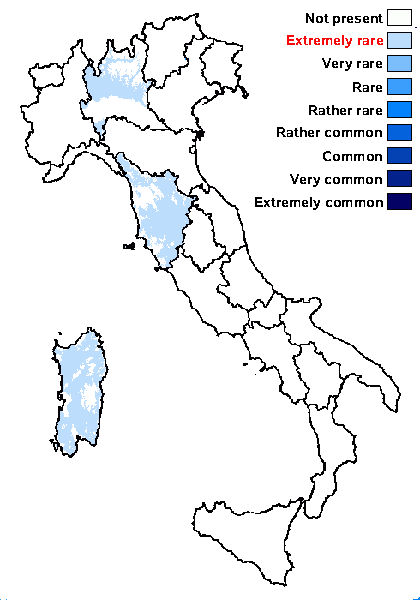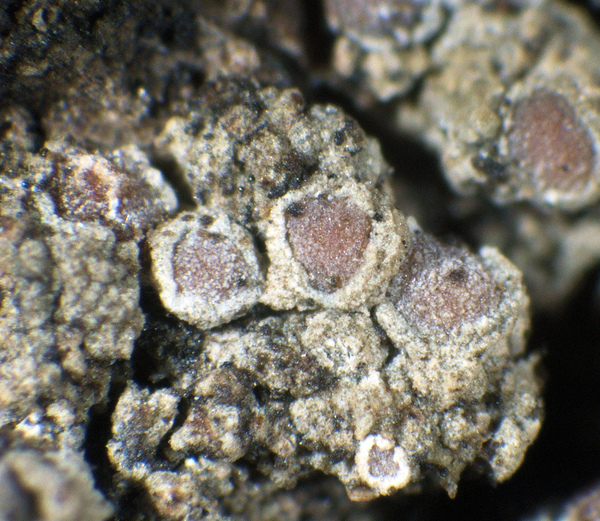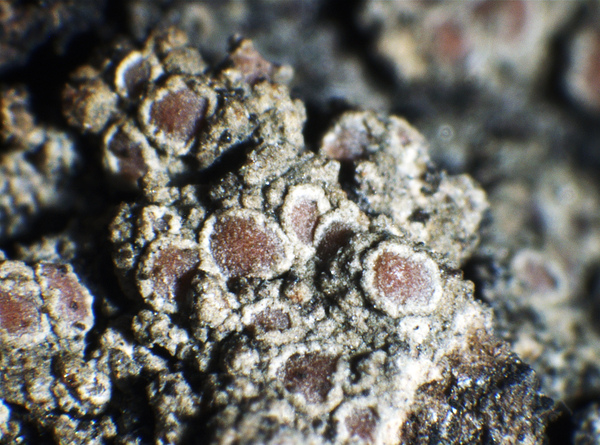Lecanoropsis quercicola (Coppins & P. James) Ivanovich
in Ivanovich & al., Phytotaxa, 695, 1: 38, 2025. Basionym: Lecanora quercicola Coppins & P. James - Lichenologist, 11: 145, 1979.
Synonyms:
Distribution: N - Lomb (Zocchi & al. 1997). C - Tosc, Sar (B 60 0153517, det Z. Palice).
Description: Thallus crustose, episubstratic, rimose-areolate to warted, rarely granular, yellowish grey, grey or pale grey-brown, without a distinct prothallus. Apothecia lecanorine, 0.2-0.5(-0.7) mm across, at first immersed, then sessile with a slightly constricted base, with a flat to slightly convex, pale to pinkish-grey to brown or reddish brown, often faintly pruinose disc, and an often slightly paler, whitish, persistent, more or less crenulate thalline margin. Thalline exciple thinly corticate, the outer rim filled with granules, the cortex 12-18 μm wide laterally, c. 20 μm wide at base; proper exciple often evident, yellowish, pseudoparenchymatous in inner part; epithecium colourless, N-, filled with yellowish granules; hymenium colourless, 40-50(-60) μm high; paraphyses mainly simple, (1.5-)2-2.5 μm thick at mid-level, the apical cells up to 3.5 μm wide; hypothecium colourless, 60-100 μm high. Asci 8-spored, broadly clavate, very thin-walled, with a K/I+ blue, tall tholus penetrated by a faintly amyloid apical cushion, the wall K/I-, surrounded by a blue outer layer, Lecanora-type. Ascospores 1-celled, hyaline, narrowly ellipsoid, 8-10(-12) x 4-5 μm. Pycnidia of 2 types: a) 90-100 μm wide macropycnidia producing slightly curved, macroconidia (always present) measuring 8.5-9.3 x (2.5-)2.7-3(-3.2) μm, b) up to 70-90 μm wide micropycnidia producing curved, pointed microconidia (rare) measuring 10-11 x c. 1 µm. Photobiont chlorococcoid. Spot tests: thallus K- or K+ faintly yellow, C-, KC-, P-, UV+ grey-white. Chemistry: isousnic acid, variable amounts of neousnic acid.
Note: on well-lit boles of ancient deciduous trees (e.g. Quercus, Castanea); mainly Tyrrhenian, but also reported from the Austrian Alps. It is included in the Italian red list of epiphytic lichens as “Critically Endangered” (Nascimbene & al. 2013c). For further details see van den Boom & Brand (2008) and Ivanovich & al. (2025).
Growth form: Crustose
Substrata: bark
Photobiont: green algae other than Trentepohlia
Reproductive strategy: mainly sexual
Most common in areas with a humid-warm climate (e.g. most of Tyrrenian Italy)
Commonnes-rarity: (info)
Alpine belt: absent
Subalpine belt: absent
Oromediterranean belt: absent
Montane belt: absent
Submediterranean belt: extremely rare
Padanian area: absent
Humid submediterranean belt: extremely rare
Humid mediterranean belt: absent
Dry mediterranean belt: absent

Predictive model
Herbarium samples
Growth form: Crustose
Substrata: bark
Photobiont: green algae other than Trentepohlia
Reproductive strategy: mainly sexual
Most common in areas with a humid-warm climate (e.g. most of Tyrrenian Italy)
Commonnes-rarity: (info)
Alpine belt: absent
Subalpine belt: absent
Oromediterranean belt: absent
Montane belt: absent
Submediterranean belt: extremely rare
Padanian area: absent
Humid submediterranean belt: extremely rare
Humid mediterranean belt: absent
Dry mediterranean belt: absent

Predictive model
| Herbarium samples |




